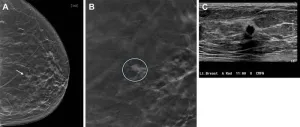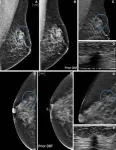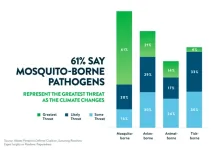(Press-News.org) OAK BROOK, Ill. – According to a new 10-year study, screening for breast cancer with digital breast tomosynthesis (DBT) increases cancer detection rates and significantly reduces the rate of advanced cancers compared to conventional 2D digital mammography. The findings were published today in Radiology, a journal of the Radiological Society of North America (RSNA).
Mammography is considered the gold standard in breast cancer screening for the general population. However, conventional 2D mammography, in which a low-dose X-ray system produces pictures of the inside of the breast from two angles, fails to detect approximately 20% of breast cancers. It is also associated with false-positive results, where an abnormality seen on a screening mammogram turns out not to be cancer after a woman has been recalled for and undergone additional tests.
DBT is an advanced form of mammography that reconstructs pictures of the breast taken from different angles into 3D images. Studies have found that DBT has a higher cancer detection rate compared to digital mammography.
“This study is the first to compare 10 years of data on breast cancers detected by DBT to digital mammography-detected cancers,” said co-author Jaskirandeep Kaur Grewal, PA-C., previous student at Yale School of Medicine Physician Associate Program.
In the retrospective study, Dr. Philpotts and a team of researchers analyzed consecutive cancer cases detected by screening mammography over 13 years at Yale University/Yale-New Haven Health. The data included 10 years of mammograms performed with DBT, which became the standard at Yale facilities beginning in 2011, and the preceding three years of mammograms performed with digital mammography.
The study cohort included 272,938 screening mammograms, of which 35,544 were performed with digital mammography, and 237,394 were performed with DBT. A total of 1,407 cancers were detected, 142 by mammography and 1,265 by DBT.
“Overdiagnosis has been a hot topic in mammography screening. Skeptics of mammography screening believe that the use of DBT results in overdiagnosis,” said first co-author Liane Elizabeth Philpotts, M.D., professor of radiology and biomedical imaging at Yale School of Medicine in New Haven, Connecticut.
Overdiagnosis means the cancers found are not clinically relevant and may not cause a health concern for the patient if left undetected.
According to Dr. Philpotts, digital mammography and DBT detected various subtypes and grades of tumors at similar rates. The ratio of invasive cancers to ductal carcinoma in situ (DCIS) did not differ significantly between the two modalities.
“We found that digital mammography and DBT screening mammography found the same types of cancers, but at different stages,” she said. “DBT found more aggressive cancers at an earlier stage compared to digital mammography.”
DBT had a higher cancer detection rate than mammography (5.3% versus 4.0%) and a lower rate of advanced cancers (32.7% versus 43.6%), indicating that cancers are likely being detected earlier. Cancer detection was improved when women had repeat mammograms with DBT.
Most true-positive cancer cases detected by DBT presented as masses, while fewer presented as calcifications and asymmetries.
The recall rate for DBT (7.2%) was significantly lower than for digital mammography (10.6%).
“DBT’s lower recall rate, higher cancer detection rate and lower rate of advanced cancers is a win, win, win,” Dr. Philpotts said. “I think this data will contribute to the debate of overdiagnosis by demonstrating that DBT is not over-diagnosing cancers. It’s finding the bad actors earlier.”
Dr. Philpotts said additional studies using long-term data are needed to better understand the role of DBT in screening outcomes.
“These findings add to the growing literature regarding cancer detection with DBT and support its use in screening mammography in the United States and globally,” Dr. Philpotts said. “Our results may provide healthcare institutions that have not yet switched from digital mammography to DBT with the data they need to adopt the newer technology.”
###
“Breast Cancers Detected during a Decade of Screening with Digital Breast Tomosynthesis: Comparison with Digital Mammography.” Collaborating with Dr. Philpotts and Grewal were Laura Jean Horvath, M.D., Michelle Young Giwerc, PA-C, Lawrence Staib, Ph.D., and Maryam Etesam, M.D.
Radiology is edited by Linda Moy, M.D., New York University, New York, N.Y., and owned and published by the Radiological Society of North America, Inc. (https://pubs.rsna.org/journal/radiology)
RSNA is an association of radiologists, radiation oncologists, medical physicists and related scientists promoting excellence in patient care and health care delivery through education, research and technologic innovation. The Society is based in Oak Brook, Illinois. (RSNA.org)
For patient-friendly information on breast tomosynthesis, visit RadiologyInfo.org.
END
Invitation for Members of the Press
How can climate adaptation succeed in the long run?
On the basis of nine case studies from around the world, the Hamburg Climate Futures Outlook 2024 identifies the conditions for successfully and sustainably adapting to the impacts of climate change. A study recently released by the University of Hamburg’s Cluster of Excellence for climate research (CLICCS) demonstrates the urgent need for developing new adaptation strategies while also reducing climate-harmful emissions – and offers corresponding practical recommendations.
As in past installments, the experts assessed ten key social processes that are relevant for deep ...
WASHINGTON—Consuming moderate amounts of coffee and caffeine regularly may offer a protective effect against developing multiple cardiometabolic diseases, including type 2 diabetes, coronary heart disease and stroke, according to new research published in the Endocrine Society’s Journal of Clinical Endocrinology & Metabolism.
Researchers found that regular coffee or caffeine intake, especially at moderate levels, was associated with a lower risk of new-onset cardiometabolic multimorbidity (CM), which refers to the coexistence of at least two cardiometabolic diseases.
The prevalence of individuals with multiple ...
New York, NY (September 17, 2024) – A new four-year, $3.26 million grant from the National Institute of Neurological Disorders and Stroke (NINDS), a part of the National Institutes of Health (NIH), establishes the first Undiagnosed Diseases Network (UDN) site in the New York metropolitan area. Patients of all ages with difficult-to-diagnose diseases can apply to have their cases studied intensively by the new Mount Sinai Center for Undiagnosed Diseases using state-of-the-art genomic approaches as soon as the beginning of 2025.
These funds expand the work of the Undiagnosed Diseases Program, previously ...
New York, NY. September 17. The Lupus Research Alliance (LRA) is pleased to announce the recipients of the 2024 Career Development and Postdoctoral Awards to Promote Diversity in Lupus Research. Launched in 2021, the Diversity in Lupus Research (DLR) Awards aim to foster the development and productivity of exceptional early-career and postdoctoral scientists from underrepresented minority groups in science.
Lupus is a debilitating autoimmune disease that disproportionately affects Black, Hispanic, Indigenous, and Asian/Pacific Islander people. The LRA inaugurated the DLR Awards three years ...
Survey reveals that infectious disease experts see the need to address gaps in surveillance programs to identify emerging pathogens, public health funding and testing infrastructure capabilities
They point to viral pathogens and mosquito-borne pathogens as likely to spark outbreaks as humans, animals and viruses overlap; and new viruses are as concerning as changes to existing viruses
Experts believe robust tracking of changing insect range, animal habitats and their migrations and extreme weather events are important to understanding infectious diseases and changing risk patterns
ABBOTT PARK, Ill., ...
In a new study, MIT physicists propose that if most of the dark matter in the universe is made up of microscopic primordial black holes — an idea first proposed in the 1970s — then these gravitational dwarfs should zoom through our solar system at least once per decade. A flyby like this, the researchers predict, would introduce a wobble into Mars’ orbit, to a degree that today’s technology could actually detect.
Such a detection could lend support to the idea that primordial black holes are a primary source of dark matter throughout the universe.
“Given decades of precision ...
Images
A key step toward reusing CO2 to make sustainable fuels is chaining carbon atoms together, and an artificial photosynthesis system developed at the University of Michigan can bind two of them into hydrocarbons with field-leading performance.
The system produces ethylene with efficiency, yield and longevity well above other artificial photosynthesis systems. Ethylene is a hydrocarbon typically used in plastics, so one direct application of the system would be to harvest carbon dioxide that would otherwise be vented into the atmosphere for making plastics.
"The performance, or the activity and stability, is about five to six times better than what is typically reported ...
Doctors and pharmacists treating people with blood thinners can reduce the rate of inappropriate dosing — as well as blood clots and strokes that can result from it — using an electronic patient management system, a study suggests.
The online dashboard, developed by the United States Veterans Health Administration in 2016, was designed to highlight and optimize the treatment of patients with direct oral anticoagulants, or DOACs, the most commonly prescribed blood thinners.
Researchers led by Michigan Medicine used the tool to assess over 120,000 cases in which patients with atrial fibrillation or venous thromboembolism, blood clots in the veins, were treated with ...
UPTON, N.Y. — The Blavatnik Family Foundation and the New York Academy of Sciences have recognized chemical engineer Juan Jimenez as a Finalist in the 2024 Blavatnik Regional Awards for Young Scientists. Jimenez’s catalysis science research at the U.S. Department of Energy’s (DOE) Brookhaven National Laboratory opens doors for turning climate change-driving gases into industrially useful materials.
The yearly honor is awarded to distinguished early career researchers at institutions in ...
NEW YORK – September 17, 2024 – The Blavatnik Family Foundation and The New York Academy of Sciences today announced the three Laureates and six Finalists of the 2024 Blavatnik Regional Awards for Young Scientists. The Awards honor outstanding postdoctoral scientists from academic research institutions across New York, New Jersey, and Connecticut.
The Blavatnik Regional Awards jury, consisting of distinguished scientists and engineers, selected one Laureate in each category who will receive a $30,000 unrestricted prize and two Finalists in each category who will be awarded $10,000 ...







